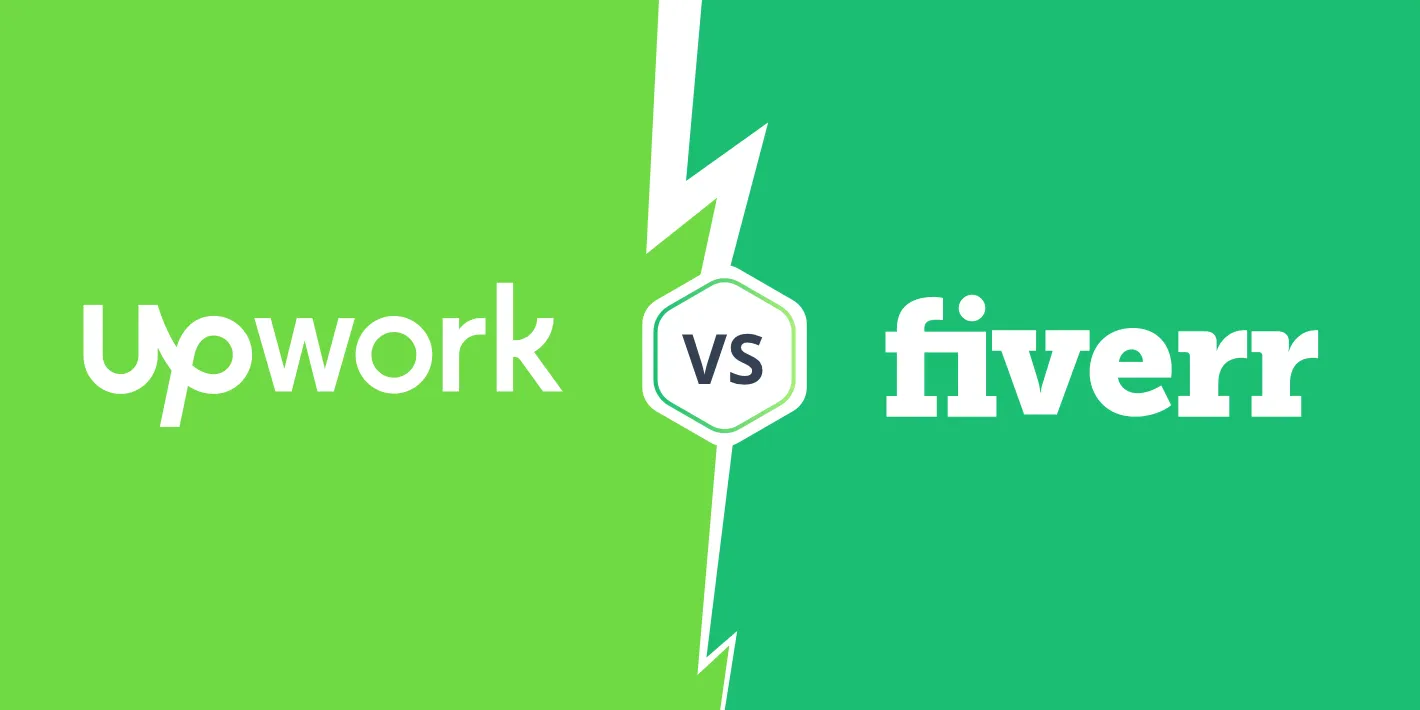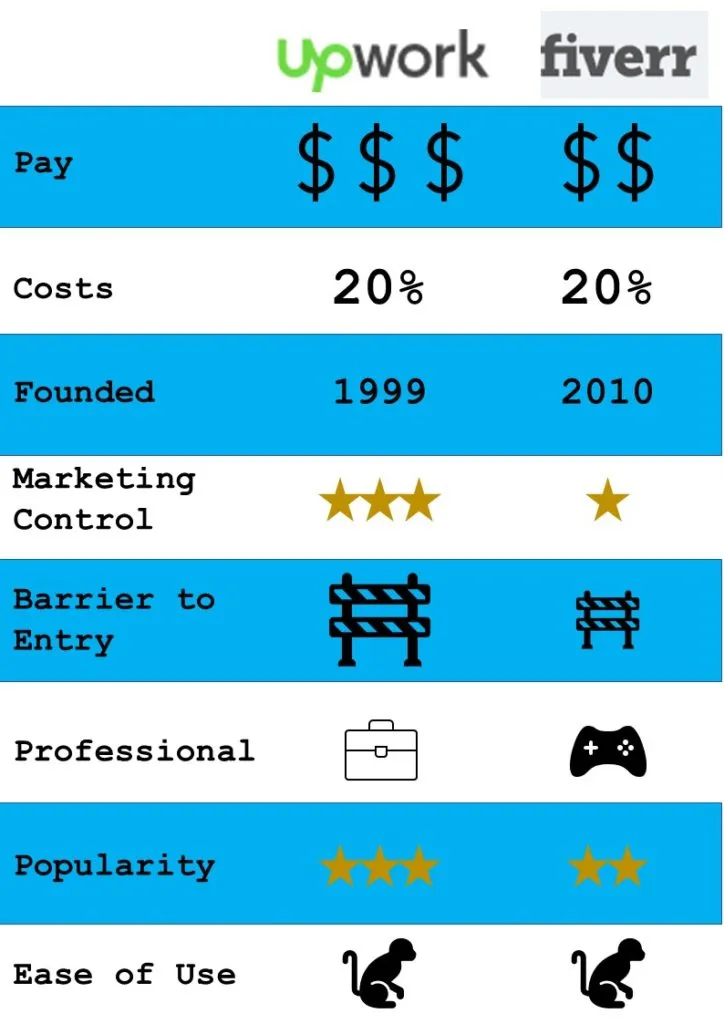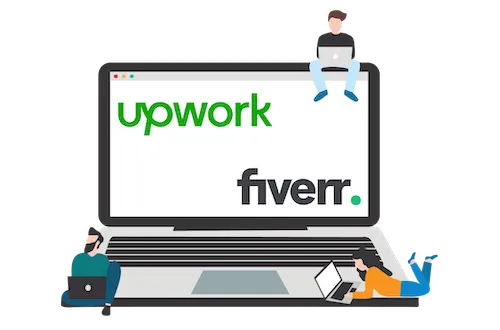In the dynamic world of freelancing, platforms like Upwork and Fiverr play pivotal roles in connecting freelancers with potential clients. While both are popular choices for those looking to hire or be hired, they operate quite differently. In this post, we'll delve into the unique features, benefits, and challenges of Upwork and Fiverr, helping you understand which platform might be the better fit for your needs. Whether you're a seasoned freelancer or a business owner in search of talent, knowing the differences can enhance your experience and efficiency.
2. Overview of Upwork

Upwork is a robust freelancing platform designed for serious professionals and businesses alike. Founded in 2015, it emerged from the merger of Elance and oDesk, creating a comprehensive marketplace for freelance services. Here’s a closer look at what makes Upwork distinct:
- Project-Based Work: Upwork primarily focuses on project-based work, allowing clients to post detailed job descriptions and freelancers to submit proposals. This structure supports various project durations, from short-term tasks to long-term collaborations.
- Diverse Skill Categories: The platform hosts a vast array of skill categories, ranging from graphic design and writing to software development and marketing, catering to diverse industries and expertise levels.
- Talent Pool: Upwork boasts a global pool of over 12 million freelancers, providing clients with a wide range of talent to choose from. This means that no matter the complexity of your project, there’s likely to be someone on Upwork with the right skills.
- Payment Structures: Upwork offers flexible payment options, including hourly rates and fixed-price contracts. Additionally, it provides a secure escrow system, ensuring that funds are only released when clients are satisfied with the work.
- User Profiles and Reviews: Freelancers create detailed profiles showcasing their skills, experience, and previous work, supplemented by client reviews. This transparency helps clients make informed decisions when hiring freelancers.
In summary, Upwork is a comprehensive platform that caters to a variety of professional needs, prioritizing quality and reliability in freelance connections. Whether you're looking to tackle a small project or engage a freelancer for a more extensive commitment, Upwork provides a structured space to facilitate that exchange.
Also Read This: Understanding Pending Clearance on Fiverr
Overview of Fiverr

Fiverr is a unique online platform that connects freelancers with clients looking for specific services. Launched in 2010, it changed the way people approach freelance work, allowing professionals to offer their skills starting at just $5. The name 'Fiverr' stems from this low entry price, but over the years, the platform has evolved to include services that range from basic offerings to premium packages costing hundreds or even thousands of dollars.
The platform primarily focuses on “gigs” or individual service offerings, which freelancers create and list in various categories. These categories include:
- Graphic Design
- Digital Marketing
- Writing & Translation
- Video & Animation
- Music & Audio
- Programming & Tech
- Business
- Lifestyle
One of the standout features of Fiverr is its user-friendly interface, enabling clients to easily navigate through services, view freelancer profiles, and make informed choices based on ratings, reviews, and delivery times.
Freelancers on Fiverr are encouraged to create eye-catching gig descriptions, promotional videos, and attractive visuals to attract potential clients. Many sellers also offer add-ons or packages, allowing them to earn more than the base price, making it a very appealing option for many professionals.
Also Read This: What Freelance Transcriptionists Typically Earn
Key Differences Between Upwork and Fiverr

While both Upwork and Fiverr are popular platforms for freelancers, they cater to different audiences and offer unique approaches to freelancing. Here are some key differences:
| Aspect | Upwork | Fiverr |
|---|---|---|
| Business Model | Hourly and project-based | Fixed-price gigs |
| Service Type | Various professional services, often complex | Specific, task-oriented services |
| Client Interaction | Direct communication during proposal and job completion | Primarily through pre-defined gigs; limited direct communication |
| Freelancer Profiles | Detailed profiles with portfolios and ratings | Concise gig listings focusing on services offered |
| Pricing Flexibility | Freelancers set their own rates based on hourly or project fees | Gigs start at $5, but prices can vary based on extras |
| Target Audience | Businesses and individuals seeking skilled professionals | Individuals looking for quick, niche solutions |
In summary, while Upwork is more suited for comprehensive projects requiring ongoing collaboration, Fiverr excels in offering specialized services that can be completed quickly. Understanding these differences can help you choose the right platform depending on your needs.
Also Read This: How to Get Traffic on Fiverr
4.1. Platform Structure
When diving into the realms of freelance marketplaces, understanding their structure can help you choose the right platform for your needs. Both Upwork and Fiverr have unique architectures that cater to different styles of working and collaborating.
Upwork operates on a more traditional job board model, where freelancers can create profiles showcasing their skills and experience. Clients post job listings that detail their needs, and freelancers can pitch to these listings. This encourages a competitive environment where freelancers can tailor their proposals to specific projects and clients. The platform supports a diverse array of jobs, ranging from short-term gigs to long-term contracts. Key components include:
- Job Postings: Clients create detailed descriptions of what they need.
- Proposals: Freelancers submit tailored proposals to land the job.
- Escrow Payments: Funds are securely held until the job is completed.
In contrast, Fiverr takes a more service-oriented approach. Freelancers list their services as "gigs" at fixed prices. Clients browse available gigs and can purchase them directly without waiting for pitches. This simplifies the transaction process but may restrict the depth of custom services available. Features of Fiverr’s structure include:
- Fixed-Gig Structure: Services have set prices, making it easy for clients to budget.
- Packages: Freelancers can offer tiered packages, allowing customers to choose based on their needs.
- Instant Purchase: Clients can buy services immediately without negotiation.
Ultimately, your choice between Upwork and Fiverr might hinge on your preferred way of working: customized proposals versus ready-made services.
Also Read This: Does Fiverr Charge a Fee? Understanding the Costs Involved
4.2. Pricing Models
Understanding the pricing models of Upwork and Fiverr can help you budget better, whether you’re a freelancer setting prices or a client seeking services.
On Upwork, the pricing model is primarily based on hourly rates or project-based payment. Freelancers have the flexibility to set their hourly rate, which can vary significantly based on their experience, skills, and the complexity of the job. Here’s how it generally breaks down:
| Payment Type | Description |
|---|---|
| Hourly Rate | Freelancers charge clients for each hour worked, tracked through Upwork’s time-tracking tool. |
| Fixed Price | Freelancers quote a total price for completed work, typically for defined projects. |
The platform takes a service fee based on the total amount billed to the client, which often scales down as freelancers grow their client relationships:
- 20% for the first $500 billed to a client
- 10% for billings between $500.01 and $10,000
- 5% for billings over $10,000
On the other hand, Fiverr operates on a fixed-price model. Freelancers set predetermined prices for their gigs, starting as low as $5 and going up significantly based on the complexity and demand. Fiverr also offers add-ons that clients can choose to customize their orders further. Here’s a snapshot of how Fiverr’s pricing works:
- Basic Gig Price: The starting price for a service.
- Gig Extras: Additional services or faster deliveries available at an extra cost.
- Service Fees: Fiverr charges a service fee to buyers, typically a percentage of the gig price.
In summary, while Upwork offers more flexibility in pricing based on the nature of projects, Fiverr sticks to a straightforward gig pricing structure. Understanding these differences can help you choose the right platform for your freelance journey.
Also Read This: How Much Freelance Developers Make
Types of Projects and Gigs
When it comes to freelancing platforms like Upwork and Fiverr, you'll notice a significant difference in the types of projects and gigs available. Let’s dive into what each platform has to offer!
Upwork: This platform is known for larger, complex projects that often require skilled professionals. You can find a range of jobs from long-term collaborations to one-off projects across various fields. Here’s a quick look at popular project types on Upwork:
- Web Development
- Graphic Design
- Writing and Translation
- Marketing and SEO
- Data Science and Analytics
In Upwork, clients usually post jobs specifying their requirements, budgets, and timelines, which gives freelancers the opportunity to apply and negotiate. It’s particularly beneficial for businesses looking for quality work at a competitive rate, especially for ongoing projects.
Fiverr: On the other hand, Fiverr operates on a gig-based model. This means freelancers offer specific services or “gigs” with fixed prices starting from $5 (hence the name). Gigs can be anything from writing an eBook to creating a catchy jingle. Here are some of the popular gig categories on Fiverr:
- Graphic Design
- Digital Marketing
- Video Editing
- Virtual Assistance
- Social Media Management
Fiverr is great for quick tasks or one-off services where clients can browse through gigs and pick one that suits their needs without the lengthy proposal process. It’s an ideal choice for those wanting to get freelance work done fast and at a fixed price.
Also Read This: How Many Warnings Until a Ban on Fiverr?
Audience and Market Focus
Understanding the audience and market focus of Upwork and Fiverr can help you navigate these platforms more effectively. Each one caters to different types of users, and knowing this can guide your choice when seeking services or showcasing your skills.
Upwork Audience: The audience on Upwork tends to be businesses—ranging from startups to established companies—looking for professional, specialized services. They are typically searching for freelancers who possess advanced skills for long-term collaborations. Here's what makes them tick:
- Quality and expertise are of utmost importance.
- They often have larger budgets for projects.
- Businesses prefer freelancers who can demonstrate a solid portfolio and testimonials.
This audience appreciates a professional approach and values communication as they often engage in projects that require ongoing support.
Fiverr Audience: Meanwhile, Fiverr caters to a broad, diverse audience, from individuals seeking to solve a quick problem to small businesses looking for affordable solutions. They are typically more price-sensitive and focused on getting a specific task completed efficiently. Key points about this audience include:
- They favor quick, straightforward gigs.
- Budget-friendly options are a big draw.
- Clients are often searching for immediate results.
Fiverr’s audience thrives on convenience and affordability, making it an excellent platform for freelancers offering a variety of services without the commitment of long-term projects.
Also Read This: What is a Search Tag on Fiverr?
4.5. Payment and Withdrawal Process
When it comes to freelancing platforms, understanding the payment and withdrawal processes is crucial for both freelancers and clients. Upwork and Fiverr have different systems in place that cater to the needs of their users.
On *Upwork, payments are typically made through a milestone system. Here’s how it works:
- Milestones: Clients can set specific goals for a project and release payments as each milestone is completed. This ensures that freelancers are compensated for their work progressively.
- Fund Escrow: Before starting a project, the client funds the milestone in escrow. This assures freelancers that the money is available.
- Withdrawal Methods: Freelancers can withdraw their earnings via various channels, including direct bank transfer, PayPal, or Payoneer. Withdrawal times can range from a few hours to several days, depending on the method chosen.
Conversely, Fiverr utilizes a different payment system:
- Gig-Based Payments: Freelancers (or sellers) receive payments per gig completed rather than through milestones.
- Clearing Period: After completing an order, there’s a 14-day clearing period before funds are available for withdrawal. This helps Fiverr manage any potential disputes that may arise.
- Withdrawal Options*: Sellers can choose from options like direct deposit, PayPal, or Fiverr Revenue Card for withdrawals. The timing can vary based on the selected option.
In summary, while Upwork emphasizes milestone-based payments providing some level of security for both clients and freelancers, Fiverr operates on a simpler gig-based model, albeit with a clearing period that can slow down access to funds.
Also Read This: How to Write a Buyer Request in Fiverr
5. Pros and Cons of Upwork
Upwork stands out as a popular choice among freelance platforms, but like any service, it has its share of advantages and disadvantages. Let’s break it down.
Pros:
- Diverse Job Opportunities: Upwork offers a broad range of categories and job types—everything from web development to writing to marketing.
- Milestone Payments: The milestone payment system provides security for freelancers, ensuring they get paid for completed work.
- Escrow Protection: Clients fund milestones upfront, adding an extra layer of trust to the process.
- Time Tracking: Upwork offers built-in time tracking tools, enabling freelancers to log hours easily and invoice clients based on tracked time.
Cons:
- Service Fees: Upwork charges freelancers a fee that can range from 5% to 20%, which can eat into earnings, especially for smaller projects.
- Competitive Environment: The platform’s popularity means there’s stiff competition among freelancers, making it harder to stand out.
- Lengthy Approval Process: New freelancers go through a profile approval process that may delay getting started on the platform.
- Potential for Low-Budget Clients: Some clients look for the lowest bids, which may undervalue skilled freelancers’ work.
Ultimately, Upwork provides a solid platform for freelancers willing to navigate its complexities and competition. Its features attract a diverse array of jobs, but freelancers must consider service fees and market competition while pursuing opportunities.
Also Read This: What Freelance Architects Typically Earn
Pros and Cons of Fiverr
Fiverr, a popular platform for freelancers, has its own set of advantages and disadvantages that can affect both freelancers and clients. Let’s break it down!
Pros of Fiverr:
- Affordability: Many gigs start at just $5, making it a great option for those on a budget.
- Diverse Services: You’ll find a vast range of services offered by freelancers, from graphic design to writing to voiceovers.
- User-Friendly Interface: Fiverr is easy to navigate, allowing users to find gigs quickly using search filters.
- Instant Access: You can purchase services instantly without the back-and-forth that sometimes comes with proposals.
- Variety of Freelancers: With thousands of active freelancers, you have many choices at your disposal.
Cons of Fiverr:
- Quality Variation: The sheer number of freelancers means quality can vary greatly, which might lead to unsatisfactory outcomes.
- Limited Customization: Gigs usually have set prices and services, which can limit personalization.
- Service Fees: Fiverr charges service fees from both buyers and sellers, which can affect pricing.
- Overcrowded Market: The competition is fierce, making it challenging for new freelancers to get noticed.
- Seller Levels: Fiverr uses a tiered system that can limit newer sellers' visibility and opportunities.
Also Read This: Can You Sell Feet Pics on Fiverr?
Which Platform is Best for You?
Choosing between Upwork and Fiverr can be a tough decision, and it all depends on your needs and preferences as either a freelancer or a client. Here’s a breakdown to help you decide!
If you are a freelancer:
- If you prefer long-term projects and building lasting client relationships, Upwork may be your go-to choice.
- On the other hand, if you enjoy offering specific services and are comfortable with a gig-based structure, Fiverr might be more suitable.
- Furthermore, if you want to showcase a portfolio and gain feedback from clients, Upwork facilitates that better than Fiverr.
If you are a client:
- If you need ongoing support or collaboration on multiple tasks, Upwork offers features to manage projects effectively.
- If you are looking for quick, one-off tasks at budget prices, Fiverr’s gig system allows for rapid hiring.
- Consider also the urgency of your project; Fiverr often has freelancers available for immediate work, while Upwork may take time for the proposal process.
Ultimately, it’s about what aligns best with your goals! Both platforms have their charm and strengths depending on the project or service you’re looking for.
How Are Upwork and Fiverr Different?
Upwork and Fiverr are two prominent platforms that serve freelancers and clients seeking services across various fields. While both platforms enable users to connect and transact, their models, functionalities, and user experiences differ significantly. Below, we explore these differences in detail.
1. Business Model:
- Upwork: Operates on a bidding system where freelancers submit proposals for jobs posted by clients. Clients then choose the freelancer they want based on their proposals, expertise, and ratings.
- Fiverr: Functions on a "gig" economy model where freelancers offer predefined services at set prices, starting at $5. Clients choose from these offerings directly without a bidding process.
2. Service Types:
- Upwork: Caters to a broader range of professional services, including long-term projects, hourly jobs, and contract-based work.
- Fiverr: Best suited for small, quick tasks or creative gigs, like graphic design, writing, and digital marketing.
3. Payment Structures:
- Upwork: Charges service fees based on freelancer earnings, starting at 20% for the first $500 billed to a client, decreasing as the billings increase.
- Fiverr: Retains 20% of each transaction from the freelancer's earnings, regardless of the amount billed.
4. Audience:
- Upwork: Primarily targeted towards businesses and startups looking for professional, long-term collaborations.
- Fiverr: Attracts individual clients and small businesses seeking quick services at a lower price point.
In summary, while both Upwork and Fiverr are excellent platforms for freelancers, their operational models, types of services offered, and target audiences differentiate them significantly. Choosing the right platform depends on your specific needs, whether you're a freelancer looking to offer services or a client seeking skilled professionals.



